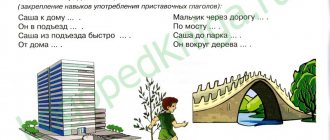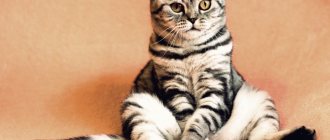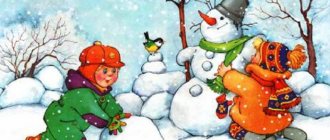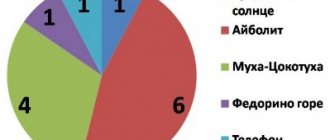Game 1. We treat guests. We play with words.
We learn to form new words from known ones (names of tableware).
Meet Tanya and Vanya. Their friends came to visit Tanya and Vanya. The guys invited the guests to the table. Look at the pictures and name what dishes the children put on the table. For oil - a butter dish, and for salt -...? (Salt shaker) For soup - a tureen, for sweets - ...? (candy bowl), for sugar - ...? (sugar bowl), for bread -... (bread box). For milk - a milk jug, for salad - ...? (salad bowl), and for coffee -...? (coffee pot). What kind of dishes does your mother put on the table when guests come to you? (carefully look at the dishes at home, name them, look at the details and name them - handle, spout, lid, bottom)
Listen to a poem about dishes. (The poem “Dispute” will help the child learn to correctly name different dishes. While reading, show the child the dishes shown in the picture)
I came up with this poem for classes with children, and they really liked it. It also helped me quickly learn the names of different utensils. I hope that you and your children will get great pleasure from the poems in pictures.
You will find this poem in pictures, as well as other tasks in pictures, in the article “Pictures of dishes for children”
You will find a presentation on this poem with pictures in good resolution for more convenient viewing with children in our VKontakte group “Child development from birth to school” (section of the “Documents” group on the right under the group video)
Dispute.
Once the dishes started arguing, Who is the most important in the world? “I’m more important,” the teapot told everyone. I warm tea for people.
“And without us they won’t be able to eat the soup. A spoon is also a friend to people.” Then the pots answered them: “You can’t cook dinner without us!”
The frying pan hissed: “That’s what I wanted to say. I fry cutlets for people, and potatoes, and omelettes.”
Stop this argument, useless conversation. We need all the dishes, each one is important to us.
We put butter in a butter dish , pour salt into a salt shaker . We put bread in the bread bin , and take soup from the tureen .
We also have a kettle with tea. We don’t miss drinking tea And pour sweet sugar from a bright sugar bowl
There is a milk jug with milk and a coffee pot with a rim. There are candies in the candy bowl for both Masha and Sveta.
There are a lot of different dishes and we need them everywhere! And we cook, and we eat, and we store food in it. (Author - Valasina A.V.)
Why do people need different dishes? What would happen if there were no dishes?
Read the poem again and ask your child to finish the words after you - the names of the utensils. For example, “We put butter in the oil...(liner), pour salt in the salt...(lonker)."
Game 2. What's missing?
We learn to accurately name the parts of the dishes. We learn to use the genitive case in speech.
Let's remember the fairy tale by K.I. Chukovsky “Fedorino's grief”.
Tell me why the dishes ran away from Fedora? Look at Fedora's broken dishes. What is missing from a cup, pan, teapot?
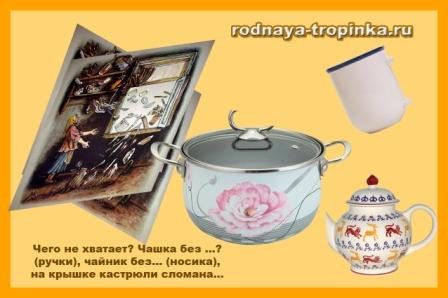
“A cup without...(handle).”
“A saucepan without...(lid).”
“A teapot without ... (spout).”
-Is it convenient to use a cup without a handle? Why? Why do cups have a handle? What other utensils have a handle? (At the frying pan, at the saucepan, at the kettle, at the milk jug, at the coffee pot). Why do these items need handles?
-Why do you need a lid on the pan? What other items have you seen with lids?
-Can I use a kettle without a spout? Why? What other objects have a spout? (At the watering can, at the coffee pot, at the milkman). What is the spout for?
Why did the dishes return to Fedora? What would happen if the dishes didn't come home? How did Fedora begin to take care of her dishes? (Washed it, cleaned it, doused it with boiling water, rinsed it, didn’t beat it...)
Game 3. Guess the riddle.
We learn to reason, identify and accurately name the characteristics of objects.
You will need three toys or three pictures for your child to choose a answer: a frying pan, a saucepan, a kettle (but in no case should the kettle be the first in the row).
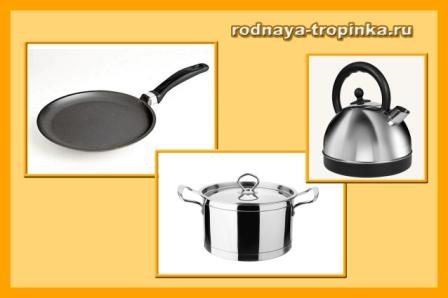
Ask your child to guess the riddle:
“I puff, puff, puff, I don’t want to get warm anymore. The lid rang loudly: “Drink tea, the water has boiled!” What is this? Find the answer.
Do not rush to give the correct answer, give the child the opportunity to reason and think. Be sure to provoke him to prove his opinion by making a deliberate mistake. You can say: “Why did you think it was a teapot? Maybe it’s a saucepan, it’s also puffing?” Let the child listen to the riddle again and try to prove his opinion. Then ask again: “Or maybe it’s a frying pan, does it get hot too?” Re-read the riddle again and find in it the signs of the object, name them together with the child: it has a lid, it puffs and warms itself on the stove, it boils water for tea. Why isn’t this a frying pan?
These deliberate mistakes, which encourage the baby to reason, can be made by Mishka - Toropyzhka or Dunno, whom you invite to solve riddles with the baby.
Tips for parents:
- Remember that it is at the age of 3-4 that a child’s word creation begins. Don’t scold your child for making up words like “for salt – Solnitsa, for butter – Maslenitsa (Shrovetide).” The child’s word creativity must be encouraged. It indicates the child’s experimentation with words, his active mental activity. Without playing with words, it is impossible to fully master the grammar of your native language in all its completeness and richness! If you make a mistake, do not repeat it after your child, just immediately say the correct version of the word: “People agreed to call the utensils for butter a butter dish, and the utensils for salt a salt shaker.”
— Games for children 3 years old should not be long. They are always funny, entertaining, and built in dialogue with the child. Having learned the names of utensils in the game, the purpose of their parts, be sure to repeat this material (look at the dishes at home, at your grandmother’s, in the store, draw your child’s attention to the interesting shapes of handles, lids, spouts, try to sketch them; if your child is already 4- 5 years, you can look at the dishes in the museum - how they differ from our dishes at home, what they are called, what they were previously used for). When examining objects, be sure to give them to the baby’s hands so that he can run his finger along the contour, determining their shape; I tried holding it with the handle and without the handle - whichever was more convenient.
continued games with children 3 years old and older in the following article: “Dishes: tasks in pictures for children”
all the pictures of the article for more convenient viewing with children in our VKontakte group (see the group section “Documents” - presentation “Dishes”, the presentation is available for editing). Or watch the presentation below. To view full screen, you need to click the arrow icon in the lower right corner of the screen.
